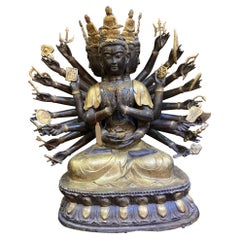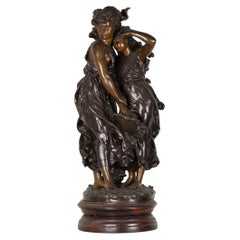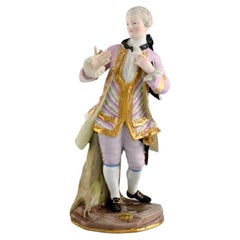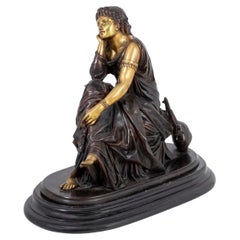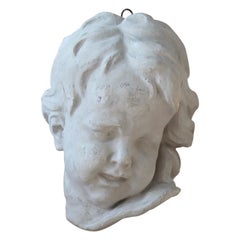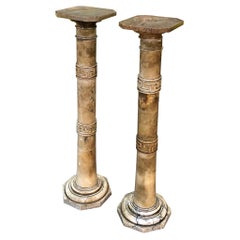19th Century Figurative Sculptures
to
436
3,742
1,148
3,742
9,123
2,776
2,281
3,225
2,055
304
156
560
571
253
498
569
673
389
267
277
223
148
140
78
76
36
30
29
19
13
12
7
6
4
2
1
1
2,047
1,706
1,004
831
664
1,866
1,601
3,065
1,598
711
249
247
Height
to
Width
to
3,742
3,742
3,742
73
29
27
25
19
Period: 19th Century
Antique Tibetan Praying Crowned Buddha
Located in Chicago, IL
Antique Tibetan Praying Crowned Buddha
This buddha sits in a seating lotus position a triangular base. His many hands fan out behind his back. Two hands...
Category
Tibetan Tibetan Antique 19th Century Figurative Sculptures
Materials
Metal
Protection Bronze Sculpture by Francois Moreau, 19th Century
Located in Lisbon, PT
A bronze statue, two girls with the loose tunic in the wind hugging each other - Persephone the Goddess of Protection embraces the smallest girl in an act of protection.
Possesses a...
Category
French Neoclassical Antique 19th Century Figurative Sculptures
Materials
Bronze
$7,070 Sale Price
33% Off
Antique Meissen Porcelain Figure, Noble Gentleman with Gold Watch
Located in København, Copenhagen
Antique Meissen porcelain figure. A noble gentleman with a gold watch.
Late 19th century.
Measures: 19 x 9 cm.
In excellent condition.
Signed.
1st F...
Category
German Rococo Revival Antique 19th Century Figurative Sculptures
Materials
Porcelain
Pierre Schoenewerk "Erato" Patinated Bronze
Located in Astoria, NY
Pierre Alexandre Schoenewerk (French, 1820-1885) "Erato" Patinated and Gilt Bronze Sculpture, late 19th century, the seated muse with turtle-form lyre, on an oval base, signed, and c...
Category
French Neoclassical Antique 19th Century Figurative Sculptures
Materials
Marble, Bronze
19th C Domenico Brucciani Oversized Putto Plaster Classical Bust Grand Tour
Located in Lowestoft, GB
A elegant D Brucciani plaster cast classical mask of a Putto
Domenico Brucciani was born in Lucca, Italy in 1815. He moved to London where he estab...
Category
English Neoclassical Antique 19th Century Figurative Sculptures
Materials
Plaster
Pair 19th Century Solid Marble Louis XVI Pedestals ~ Columns
Located in Dallas, TX
PAIR 19th century solid marble Louis XVI Pedestals ~ Columns were designed to provide symmetry while displaying a particularly special work of art, sculpture, vase or other keepsake....
Category
French Neoclassical Revival Antique 19th Century Figurative Sculptures
Materials
Marble
Study of a Satyr - Italy, early 19th century
Located in Bruxelles, BE
Study of a Satyr
Bronze, cast using the lost-wax (cire perdue) method
Italy, early 19th century
14 x 7 x 10 cm
This evocative bronze sculpture represents a satyr, the half-human, h...
Category
Italian Modern Antique 19th Century Figurative Sculptures
Materials
Bronze
19th Century Bronze Statue of a Nymph by A. Carrier
Located in Vancouver, British Columbia
A very fine cast and chased bronze showing a beautiful standing nude nymph, parting and emerging from between tall bull rushes at the edge of a stream. At her feet is a water jug. Th...
Category
French Napoleon III Antique 19th Century Figurative Sculptures
Materials
Bronze
$6,160 Sale Price
30% Off
Italian Baroque Painted and Gilt Wood Winged Angel Playing a Violin
Located in Stamford, CT
19th Italian Baroque style carved, painted and gilt wood winged angel playing a violin. This utterly charming piece is wonderfully carved by a true artist and artisan. Just look at t...
Category
Italian Baroque Antique 19th Century Figurative Sculptures
Materials
Giltwood
Antoine Louis Barye (1795-1875), ' Theseus fighting the centaur Bianor'
Located in Brighton, West Sussex
A Fine Patinated Bronze Group, Entitled 'Thesée Combattant le Centaure Bianor' ('Theseus Fighting the Centaur Bianor'), Cast by Ferdinand Barbedienne, From the Model By Antoine Louis...
Category
French Classical Greek Antique 19th Century Figurative Sculptures
Materials
Bronze
Recumbent Lion Bronze
By G. None
Located in Bronx, NY
This vintage 19th century French bronze sculpture is artist signed and bears a family seal. The stunning sculpture portrays a majestic recumbent lion is beautifully rendered by the n...
Category
French Neoclassical Antique 19th Century Figurative Sculptures
Materials
Bronze
$1,000
Antique Bronze Putti on Marble Base styled after Albert-Ernest Carrier-Belleuse
Located in Chicago, IL
Antique Bronze Putti Sculpture on Marble Base styled after Albert-Ernest Carrier-Belleuse
Albert-Ernest Carrier-Belleuse (1824-1887) created the sculpture known as the, “Allegorie d...
Category
Unknown Baroque Revival Antique 19th Century Figurative Sculptures
Materials
Marble, Bronze
Bookends depicting the heads of black labrador dogs, England 1890.
Located in Milan, IT
Large pair of carved and lacquered black wooden bookends, depicting two black Labrador dog heads. England, late 19th century.
Category
English Antique 19th Century Figurative Sculptures
Materials
Wood
19th Century Bronze Statue: Bacchante
Located in Paris, FR
This statue featuring a Bacchante is crafted of patinated bronze. In Roman mythology, Bacchae, or Bacchantes, were the female followers of Bacchus. They were often depicted in the co...
Category
French Napoleon III Antique 19th Century Figurative Sculptures
Materials
Griotte Marble, Bronze
An Antique French Bronze signed Auguste Moreau, Late 19th Century
Located in Lambertville, NJ
A late 19th Century Art Nouveau patinated bronze sculpture of a young boy with instrument. Artist signed Auguste Morea, with the French bronze hallmark on base. 24 inches tall
Category
Art Nouveau Antique 19th Century Figurative Sculptures
Materials
Bronze
French Bronze Sculptures from the 19th Century, Guèridon Statues
Located in Cesena, FC
French bronze sculptures from the 19th century - guèridon statues
(from the second half of the 1800s)
Two young girls in neoclassical clothing are depicted in the round: one holdin...
Category
French Antique 19th Century Figurative Sculptures
Materials
Bronze
Pair of 19th Century French Classical Finely Cast Bronze Maiden Statues
Located in Philadelphia, PA
Quality pair of 19th century figural bronze statues. The pair features left and right facing maidens holding urn form vessels. The casting is of superior quality as can be seen by th...
Category
French Classical Greek Antique 19th Century Figurative Sculptures
Materials
Bronze
Grotto Metal Footed Dish, a Pair
Located in Los Angeles, CA
Beautiful pair of metal footed dish grotto style with men riding giant fish figurines. Great carving details.
Category
Italian Other Antique 19th Century Figurative Sculptures
Materials
Metal
$1,100 / set
Rare Brass Applique of Abundanita the Goddess of Abundance
Located in New York, NY
Abundanita, the Goddess of abundance, symbolizes money flow, prosperity, fortune, valuables and success. This rare applique is made of brass and has the inscription Lire on its surfa...
Category
Antique 19th Century Figurative Sculptures
Materials
Brass
Vainqueur (Victorious) French Bronze by E. Marioton (1857-1933)
Located in Atlanta, GA
Vainqueur (Victorious) A Very Fine French Bronze by Eugene Marioton (1857-1933), excellent condition, depicting a young warrior with right arm extended holding a laurel branch- left ...
Category
French Antique 19th Century Figurative Sculptures
Materials
Bronze
Antique Meiji Signed Japanese Figural Woman & Lantern Incense Burner with Base
Located in Hamilton, Ontario
This large antique Meiji period Japanese patinated and polychromed bronze is signed by an unknown artist and presumed to have been made in approximately 1880 in the period Meiji styl...
Category
Japanese Meiji Antique 19th Century Figurative Sculptures
Materials
Bronze
19th Century Orientalist French Bronze Statue of Arabian Warrior
Located in New York, NY
Large patinated bronze figure of a proud Middle Eastern male. Signed in the cast, Koenig with Patent 1888 Paris. Apparently designed as a stick stand.
Category
French Antique 19th Century Figurative Sculptures
Materials
Bronze
French 19th Century, Whimsical Rococo Style Marble Carved Planter with Children
Located in Los Angeles, CA
A fine French 19th century whimsical Rococo style white marble carved planter jardinière with figures of playful Putti 'Children' playing with a goats among trees and vines, raised o...
Category
French Rococo Revival Antique 19th Century Figurative Sculptures
Materials
Marble
Statue of St Florian, around 1880
Located in Greding, DE
Life-size statue of St Florian holding a palm frond in his hand. The statue is made of Pietra di Vicenza and has a beautiful natural patina.
Category
German Antique 19th Century Figurative Sculptures
Materials
Stone
Italian Marble Sculpture of Venus by Cesare Lapini
Located in New York, NY
Carrara white marble sculpture of Venus by the Italian master, Cesare Lapini (1848-c1890), measuring 28 1/2 inches tall. Signed in script and dated C Lapini Firenze 1885.
Category
Italian Neoclassical Antique 19th Century Figurative Sculptures
Materials
Marble
$6,500 / item
A pair of Japanese Miyao Bronze Statues of a Falconer and warrior, Meiji period.
Located in Brighton, Sussex
A fine quality pair of 19th century Japanese Miyao bronze statues of a Falconer and Sumo warrior in patinated bronze with gold leaf highlights. Mounted on...
Category
Japanese Antique 19th Century Figurative Sculptures
Materials
Bronze
Late 19th Century French Classical Plaster Foot
Located in London, GB
A statement patinated plaster academic study of an oversized foot, cast from a classical sculpture. French, c. 1890.
Category
French Antique 19th Century Figurative Sculptures
Materials
Plaster
Antique Seated Greek God Hermes Patinated Grand Tour Cast Bronze Sculpture
Located in Hamilton, Ontario
This large and substantial cast bronze sculpture is unsigned, but presumed to have been made in circa 1880 for the Grand Tour. The sculpture depicts the Greek god Hermes...
Category
Italian Greek Revival Antique 19th Century Figurative Sculptures
Materials
Marble, Bronze
19th Century Pair of Venetian Carved Figural Floor Lights attributed to Besarel
Located in London, GB
A Splendid Pair of Venetian Figural Torchères
Attributed to Valentino Panciera Besarel
Of solid carved pine, waxed, blackened and beeswax-polished throughout. Each figure carved wit...
Category
Italian Renaissance Revival Antique 19th Century Figurative Sculptures
Materials
Pine
Pair of French 19th Century Louis XVI St. Ormolu and Marble Statues
Located in West Palm Beach, FL
An exceptional and most charming true pair of French 19th century Louis XVI st. ormolu and Rouge Griotte marble statues. Each statue is raised by a Fine circular Rouge Griotte marble...
Category
French Louis XVI Antique 19th Century Figurative Sculptures
Materials
Marble, Ormolu
19th Century Art Nouveau Pair of French Bronze Mermen Candlesticks
Located in London, GB
A highly decorAtive pair of late 19th Century bronze candlesticks with two mermen knelt on bronze tripods ornately decorated holding up the candle holders with excellent hand chased ...
Category
French Art Nouveau Antique 19th Century Figurative Sculptures
Materials
Bronze
Pair of Javanese Carved Teak Figures
Located in Queens, NY
Pair of Asian Javanese (19/20th Cent) carved teak large figures with drape over shoulder and sword.
Category
Javanese Dutch Colonial Antique 19th Century Figurative Sculptures
Materials
Teak
$21,500 / set
Large Meissen Porcelain Figurine Group 'Apollo & Daphne', By Juechtzer, Ca. 1860
Located in Vienna, AT
Excellent large and rare Meissen figurine group from the 19th century:
Apollo clothed with a cloak embraces Daphne from behind, who is fleeing from him and has already frozen into a ...
Category
German Classical Roman Antique 19th Century Figurative Sculptures
Materials
Porcelain
Antique Austrian Bronze Sculpture of Napoleon on Horseback, after Alois Hernick.
Located in New Orleans, LA
Antique 19th Century Austrian Figural Bronze Sculpture on Green Marble Base of Napoleon on Horseback, after Alois Hernick (1870-1939).
Category
Austrian Antique 19th Century Figurative Sculptures
Materials
Marble, Bronze
Minton Majolica Hogarth Boy Figure
By Minton
Located in Chelmsford, Essex
Minton Majolica figure which features a Hogarth boy, sat on a rock, holding a shell. Coloration: turquoise, green, brown, are predominant. The piece bears maker's marks for the Minto...
Category
English Victorian Antique 19th Century Figurative Sculptures
Materials
Majolica
Large Roman Bronze Emperor Bust from the 19th Century
Located in Madrid, ES
LARGE Roman bronze from the 19th century. Important bronze from the end of the 19th century roman signed S.V. The black marble base is later. Grand tour of Rome. Excellent condition ...
Category
Italian Baroque Antique 19th Century Figurative Sculptures
Materials
Bronze
After Bertel Thorvaldsen 19th c. Terracotta Venus Sculpture by P. Ipsen
Located in Richmond, VA
After the renowned neoclassical sculptor Bertel Thorvaldsen (Danish, 1770-1844) comes this terracotta reduction of his "Venus with The Apple of Paris" (1805), by P. Ipsen (Danish, 18...
Category
Danish Neoclassical Antique 19th Century Figurative Sculptures
Materials
Terracotta
Pair of French Victorian Stripped Lifesize Carved Figures
Located in Queens, NY
Pair of French Victorian stripped lifesize carved male and female figures playing musical instruments with gilt trim and seated on pedestal bases.
Category
French Victorian Antique 19th Century Figurative Sculptures
Materials
Wood
French Figurative Bronze Gas Cigar Store Display
Located in Hamilton, Ontario
Made in Paris France, antique 19th century bronze African Pygmy playing cymbals with a cigar in mouth. The cigar can be lit with gas, the gas valve fitting on the back is in working ...
Category
French Antique 19th Century Figurative Sculptures
Materials
Marble, Bronze
Antique Bronze Sculpture of Hebe & Jupiter's Eagle
Located in Wormelow, Herefordshire
An antique bronze sculpture depicting Hebe and Jupiter's eagle, after Laurent-Honore Marqueste.
Dating to circa 1890, the statue depicts a female figure standing nude on a rocky out...
Category
French Neoclassical Antique 19th Century Figurative Sculptures
Materials
Bronze
Hand-Carved Batak Singa Singa Tribal Sculpture, Sumatra, Antique Decor Accent
Located in Yonkers, NY
A antique hand carved tribal sculpture from the Batak People, northern Sumatra, called a Singa Singa. This antique hand-carved tribal sculpture from the Batak People of Northern Suma...
Category
Indonesian Tribal Antique 19th Century Figurative Sculptures
Materials
Wood
A spectacular Italian 19th century Alabastro Fiorito and Ormolu statue
Located in West Palm Beach, FL
A spectacular and extremely high quality Italian 19th century Alabastro Fiorito and Ormolu statue. This striking statue is raised on a most impressive rectangular Alabastro Fiorito m...
Category
Italian Antique 19th Century Figurative Sculptures
Materials
Alabaster, Ormolu
Rare 19 Century Bronze Statue Titled "Mutualite" by Maurice Constant Favre
By Maurice Constant Favre
Located in Vancouver, British Columbia
A very rare and beautifully cast late 19th century bronze by Maurice Constant Favre (1875-1915), titled " Mutualite" depicting two bare chested muscular blacksmiths, an older stockie...
Category
French Romantic Antique 19th Century Figurative Sculptures
Materials
Bronze
Bronze Statue of the Roman Greek Wrestler Milo of Croton After Dumont
By Jacques-Edme Dumont
Located in Vancouver, British Columbia
A fairly large 19th century French bronze statue of the Milo of Croton on a stepped marble base after the original marble statue by sculptor Edme Dumont (1...
Category
French Neoclassical Antique 19th Century Figurative Sculptures
Materials
Bronze
Pair of Japanese Cast Bronze Figures of Niō, Meiji Period, Late 19th Century
Located in Austin, TX
A well cast pair of Japanese mixed metal okimono figures of Buddhist guardians, known as Nio or Dharmapala, protectors of Buddhist faith, Meiji Period, Japan.
The smiling bronze g...
Category
Japanese Meiji Antique 19th Century Figurative Sculptures
Materials
Bronze
Grotto Metal Footed Dish, a Pair
Located in Los Angeles, CA
Beautiful pair of metal footed dish grotto style with men riding giant fish hunting figurines. Great carving details.
Category
Italian Other Antique 19th Century Figurative Sculptures
Materials
Metal
$1,100 / set
Sculpture in Patinated Bronze by Auguste Lalouette, Napoleon III Period.
Located in Saint-Ouen, FR
Sculpture in patinated bronze by Auguste Lalouette, 19th century, Napoleon III period.
A sculpture by Lalouette Auguste of a Japanese woman in elega...
Category
French Napoleon III Antique 19th Century Figurative Sculptures
Materials
Bronze
Mrs Devil 'Hall Figurine Attributed to Francesco Toso, 1875-1890
Located in Madrid, ES
This is a mephistophelic figure in solid wood carved of "Mrs. Devil" in the form of a hall support. Italy 1875-1890.
Measure: Height 185 cm -
Good condition,
Mother of pearl eyes.
Category
Italian Baroque Antique 19th Century Figurative Sculptures
Materials
Wood
Small Sculpture of a Nude Boy on Malachite Base, Benjamin Schlick Mid-19th Cent
By Benjamin Schlick
Located in New York City, NY
A fine quality mid-19th century silver electroplate sculpture of a nude male figure after the antique, on original malachite base.
A classica...
Category
European Neoclassical Antique 19th Century Figurative Sculptures
Materials
Malachite
Nomoli Stone Figure, Sierra Leone, Kissi, Tribal Art
Located in Bochum, NRW
A Kissi Nomoli carved stone figure, a male with his hands wrapped around his knees, on a base; from the Kissi people of Sierra Leone.
Greyish brown patina, snout-like mouth, large no...
Category
Sierra Leonean Tribal Antique 19th Century Figurative Sculptures
Materials
Soapstone
Italian 19th Century Renaissance White Glazed Porcelain Figural Group Sculpture
Located in Firenze, IT
This compelling Italian 19th century white glazed porcelain sculpture depicts ‘The Rape of the Sabines’, after a monumental work by the Renaissance artist, Giambologna (1529-1608) th...
Category
Italian Renaissance Antique 19th Century Figurative Sculptures
Materials
Porcelain
Antique Old Paris / Vieux Porcelain Figural Chinoiserie Centerpiece
Located in Philadelphia, PA
A fine antique French porcelain centerpiece.
In the style of Jacob Petit and possibly by Hannong.
In the form of cultivated spring with...
Category
French Chinoiserie Antique 19th Century Figurative Sculptures
Materials
Porcelain
Sculpture Scipione Tadolini the Greek Slave Second Half of the 19th Century
By Scipione Tadolini
Located in SAINT-JEAN-CAP-FERRAT, FR
Scipione Tadolini was a skilled sculptor whose broad talent covered the neoclassic to the romantic movements. His ancestors from a dynasty of Roman sculptors exerted a profound and lasting influence on the artistic production of the Eternal City. The Greek Slave fully demonstrates his masterly talent and serves as a reminder of antique models and the orientalist influences characterising the second half of the 19th century.
Scipione Tadolini graduated from the Roman Academy and worked with his father on a series of celebrated portraits and ecclesiastical sculptures for Roman churches including a bust of Cardinal Giuseppe Alberghini for the Gesù (1847) and portraits of various members of the Cini family for the Church of Sant’Andrea della Valle (1844, 1846). Tadolini is also known as the author of a number of large-scale monuments for patrons around the world including an equestrian group of Simon Bolivar for the city of Lima, Peru. One of his best known sculptures is The Greek Slave which appears in his work from the late 1850s forward.The Greek Slave was created in several sizes in two variations: with the figure’s hand either raised to her chest or to her chin. The small number of versions all indicate the sculptor’s careful attention to the human form and passion with exoticism, which can be noticed through the tumbling folds of the present figure's headdress and the finely articulated jewellery...
Category
Italian Neoclassical Antique 19th Century Figurative Sculptures
Materials
Marble
Antique Italian Alabaster Sculpture of Leda & the Swan
Located in Wormelow, Herefordshire
A mid-late 19th century antique Italian alabaster sculpture depicting Leda and the Swan mounted on a green marble base. This figure of neoclassical interest is brilliantly detailed, ...
Category
Italian Neoclassical Antique 19th Century Figurative Sculptures
Materials
Alabaster, Marble
Auguste Louis Lalouette Pair of 19th c Gilt Figural Bronzes for Tiffany & Co
Located in Milford, NH
A wonderful pair of gilt bronze figures, each signed “Lalouette” on base by French sculptor Auguste Louis Lalouette (1826-1883) on red marble plinths, and stamped “Tiffany & Co”. The...
Category
French Antique 19th Century Figurative Sculptures
Materials
Marble, Bronze
Sculpture in Patinated Bronze by Adolphe Jean Lavergne, 19th Century.
Located in Saint-Ouen, FR
Sculpture in patinated bronze by Adolphe Jean Lavergne, 19th century.
Sculpture by Adolphe Jean Lavergne in patinated bronze, orientalist bronze, 19th century, Napoleon III period.
...
Category
French Napoleon III Antique 19th Century Figurative Sculptures
Materials
Bronze
Atlas Bronze Statue, Early 19th Century, Italy
Located in Roma, IT
Bronze statue with a sky-blue marble vault, on a white marble base.
Italy, early 19th century.
Dimensions: 32 x 10 x 10 cm.
Situated and shipped from Italy.
This object is shipp...
Category
Italian Antique 19th Century Figurative Sculptures
Materials
Marble, Bronze
Italian 19th century Neo-Classical st. Alabaster statue of The Three Graces
Located in West Palm Beach, FL
A beautiful Italian 19th century Neo-Classical st. Alabaster statue of The Three Graces. This wonderful Alabaster statue is raised by its original oval base with mottled edges and de...
Category
Italian Antique 19th Century Figurative Sculptures
Materials
Alabaster
Victorian Porcelain Shakespeare
By John Bell
Located in Queens, NY
English Victorian white parian porcelain figure of William Shakespeare standing by tree stump (signed JOHN BELL)
Category
English Victorian Antique 19th Century Figurative Sculptures
Materials
Porcelain
A Bronze Figure of Napoleon, 19th Century
Located in ARMADALE, VIC
A Bronze Figure of Napoleon, 19th Century
Provenance:
Private Melbourne Collection.
Description:
In full military dress, his sword sheathed and arms folded over his chest, his ri...
Category
French Empire Antique 19th Century Figurative Sculptures
Materials
Bronze
Recently Viewed
View AllMore Ways To Browse
Thai Musician
The Dying Gaul
Torso Brass
Vintage Pin Holder
War Statue
Water Maiden
Winged Cherubs Sculpture
Winged Mercury
Woman Ceramic Figurine
15th Century Angel
1880s Bronze Sculptures
1960s Mannequin
African Bronze Figure
Alabaster Head Sculpture
Alabaster Plinth
Alexandra Feodorovna
Andrea Del Verrocchio
Antique German Gnomes
